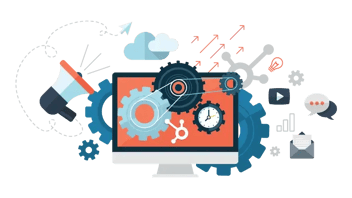由于 CRM 在客户互动中起着至关重要的作用,因此将 CRM 平台迁移到 HubSpot 对企业来说是一次战略性转变。有了这些技巧,你就可以打开通往增强功能世界的大门,确保你的数据找到一个新家,毫不费力地与 HubSpot 的动态结构保持一致。


为什么要迁移到 HubSpot?
选择正确的 CRM(客户关系管理)平台会对企业的成功产生重大影响。HubSpot 是客户关系管理市场的强者,是考虑迁移的理想选择。
HubSpot 提供全面的功能来简化和提升您的 CRM 体验。从潜在客户生成到客户参与,HubSpot 提供了一个整合营销、销售和服务功能的无缝生态系统。HubSpot 平台的集中性消除了孤岛,促进了企业内不同部门之间的协作。这种协调可确保与客户的每一个接触点都具有凝聚力,最大限度地挖掘有意义互动的潜力。
另一个引人注目的因素是 HubSpot 对用户友好界面和直观设计的承诺。HubSpot 意识到,浏览客户关系管理平台不应该令人生畏。该平台构建简单,使用户能够迅速适应并利用其功能,而无需花费大量时间学习。这种以用户为中心的方法加快了入职速度,使您的团队能够专注于最重要的事情--培养客户关系。
此外,HubSpot 以其适应性和可扩展性而闻名。随着业务的发展,您的 CRM 系统也应随之发展。HubSpot 的灵活性允许无缝定制,确保平台与您独特的业务流程保持一致。无论您是寻求灵活解决方案的初创企业,还是拥有复杂工作流程的成熟企业,HubSpot 都能满足您当前和未来的需求。
数据在现代商业环境中的重要性怎么强调都不为过。HubSpot 意识到了这一点,并提供了强大的数据管理功能。该平台的数据分析和报告工具使企业能够获得有价值的见解,从而做出明智的决策。迁移到 HubSpot,您就打开了通向大量可操作数据的大门,将原始信息转化为战略优势。
除了技术实力,HubSpot 还因其活跃的用户社区和广泛的支持资源而脱颖而出。迁移到新的CRM平台可能是一项复杂的工作,但有了 HubSpot,你就不会孤单。该平台的社区论坛、知识库和专用支持可确保随时提供帮助,从而形成一个企业可以蓬勃发展的协作生态系统。
现在,您已经了解了将 CRM 迁移到 HubSpot 的好处,让我们来讨论一下如何开始迁移过程。
评估您的数据
评估数据是CRM迁移过程中的关键一步,可确保顺利过渡到HubSpot的动态平台。这一过程包括仔细检查现有数据,以确定对业务运营至关重要的基本信息。
首先,了解评估数据的重要性至关重要。从客户联系人和互动到销售预测,您的 CRM 保存了大量信息。通过评估这些数据,您可以了解业务连续性和增长的基本要素。这是一个整理和优先排序的机会,可确保只有最相关、最有价值的信息才会迁移到HubSpot。
与关键利益相关者合作
确定迁移关键数据点的技巧包括与组织的关键利益相关者合作。销售、营销和客户服务团队通常对他们日常依赖的数据有独特的见解。通过参与跨部门讨论,可以确保迁移过程符合团队的不同需求。这种合作方式可以提高数据评估的准确性,并培养团队成员的主人翁意识。
进行兼容性检查
兼容性检查是评估数据的另一个重要方面。HubSpot 具有独特的数据结构,确保现有数据与该结构保持一致是无缝迁移的关键。评估数据的格式、字段和类别,识别迁移过程中可能出现的任何潜在不匹配。这种积极主动的方法可将数据差异的风险降至最低,并确保您的数据无缝集成到 HubSpot 的生态系统中。
计划迁移
规划向HubSpot的迁移为成功过渡奠定基础。制定一个深思熟虑的计划可确保迁移过程高效,并最大限度地减少对业务运营的干扰。
制定时间表
首先要为迁移制定切实可行的时间表。考虑数据的大小、现有 CRM 系统的复杂程度以及计划在 HubSpot 中使用的具体功能。一个定义明确的时间表有助于在企业内部设定期望值,使迁移工作有条不紊地进行,避免不必要的匆忙或延误。
分配角色和职责
分配角色和职责是下一个关键步骤。确定组织内将在迁移过程中发挥关键作用的关键人员。从数据验证到用户培训,确保迁移的每个环节都有专人负责,从而简化流程并加强责任感。
计划沟通和培训
在整个规划阶段,沟通是关键。让你的团队了解即将发生的变化,强调迁移到 HubSpot 的好处。开展培训课程,让用户熟悉HubSpot 的功能,确保顺利入职,并尽量减少对日常工作流程的干扰。
HubSpot CRM 迁移清单
如果要通过 导入进行迁移,请完成以下清单,以确保成功完成迁移:
-
导出数据/连接系统
-
首先从当前的 CRM 系统导出数据。确保您拥有包含所有必要信息的全面数据集。
-
如果直接连接系统,则在现有 CRM 和 HubSpot 之间建立安全连接,确保数据流顺畅、连续。
-
清理源数据或清理导出
-
迁移前,彻底清理源数据。删除重复记录、纠正格式问题并解决任何不一致问题。
-
如果导出数据,确保导出文件干净无误。这一步对于在迁移过程中维护 CRM 数据库和数据完整性至关重要。
-
定义对象映射
-
明确定义当前 CRM 中的对象(如联系人、交易、公司)如何映射到 HubSpot 中的相应对象。建立映射策略,避免数据错位。
-
为每个对象准备目标字段
-
在 HubSpot 中,为每个对象准备与数据映射策略一致的目标字段。确保这些字段经过适当配置,以适应导入的数据。
-
定义字段映射
-
定义源数据中的每个字段如何映射到 HubSpot 中的相应字段。这包括指定各个数据点之间的关系,并确保准确而有意义的数据传输。
-
准备导入文件和对象关联
-
将数据组织到导入文件中,将每个数据点与其对应的对象关联起来。确保数据格式符合 HubSpot 的要求,以便顺利导入。
-
测试导入
-
在执行全面迁移之前,使用数据子集进行测试导入。通过这一步骤,您可以发现并纠正实际迁移过程中可能出现的任何问题或差异。
-
审查导入的测试对象,确保字段映射、关联和参与数据正确无误
-
测试导入后,彻底检查导入的测试对象。验证字段映射是否准确、对象之间的关联是否得到维护、参与数据(如适用)是否正确传输。
通过认真遵守本检查表,用户可以确保迁移过程的彻底性和准确性,最大限度地降低数据错误的风险,优化向HubSpot CRM 的过渡。每个步骤都有助于实现无缝导入,为成功的迁移体验奠定基础。
迁移后评估
完成 CRM 迁移到 HubSpot 标志着企业新篇章的开始,而富有洞察力的迁移后评估对于衡量过渡是否成功至关重要。
-
评估数据准确性
-
对 HubSpot 中的迁移数据进行细致的审查。核实信息的准确性,确保关键细节、联系人和历史数据已无缝转移。
-
功能测试
-
在实时环境中测试 HubSpot 的功能。确保工作流、自动化和集成按预期运行,最大限度地减少对日常运营的干扰。
-
用户反馈和培训
-
收集终端用户对 HubSpot 使用体验的反馈意见。找出他们可能面临的任何痛点或挑战,并在必要时开展额外的培训课程。顺畅的迁移后用户体验对于持续的生产力至关重要。
-
性能监控
-
实时监控 HubSpot 的性能。评估系统响应速度、数据检索时间和整体效率。及时处理任何与性能相关的问题,以保持最佳功能。
-
目标实现分析
-
比较迁移前的目标和迁移后的结果。评估迁移是否有助于实现业务目标,如提高客户参与度、简化流程或提高销售效率。
-
问题解决
-
立即解决迁移后的任何问题。无论是数据差异、工作流程中断还是用户疑虑,积极主动的问题解决方法都能确保做出迅速有效的回应。
-
持续优化
-
利用 HubSpot 的报告和分析工具来确定需要优化的领域。定期审查和完善客户关系管理策略,使其适应不断变化的业务需求,从而取得持续成功。
-
利益相关者沟通
-
让利益相关者了解成功迁移及其影响。庆祝所取得的成就并宣传 HubSpot 的优势,在企业内部培养对该平台的积极看法。
寻求外部支持
虽然我们希望本指南能让您做好将 CRM 迁移到 HubSpot 的准备,但这可能会让您望而生畏。幸运的是,在迁移过程中,你并不孤单。借助专业人士的帮助将大有裨益,尤其是当你的团队不熟悉 HubSpot 时。
作为HubSpot的白金合作伙伴,Aspiration Marketing的资源可为您提供专业指导,并配备HubSpot入职认证、HubSpot认证培训师以及使您的CRM正常运行所需的专业知识。
我们团队成员的经验和洞察力可以大大缓解迁移的复杂性,提供战略性意见,确保您向 HubSpot 的过渡不仅仅是迁移,而是优化您的 CRM 功能。对于那些喜欢亲力亲为的人来说,迁移工具是非常宝贵的资源。HubSpot 提供一系列迁移工具,旨在简化迁移过程。
采用 HubSpot 为您打开了一扇门,让您可以获得增强的数据管理、动态分析和充满活力的社区,从而推动您的企业走向成功。











发表评论